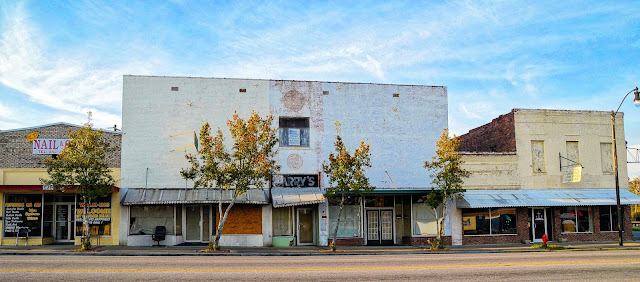It's Christmas Eve, 1912. A young, black man stands just inside the doorway of Jenkinson Brothers, a general merchandise store on Main Street in Kingstree. It's after 9 p.m., but the store and the street outside are still thronged with shoppers, revelers, and rabble-rousers. J.Z. McConnell, a special policeman on duty that night in an attempt to keep order, stands just outside the door on the sidewalk, scanning the crowds across the street at the depot. Over there, a large number of men and boys are celebrating the holiday by shooting fireworks. The noise is thunderous and incessant. Suddenly, the windows of Milhous & Jennings' grocery store, next door to Jenkinson Brothers, shatter inward as two .38-calibre slugs find their target from across the street.
Jenkinson Brothers and Milhous & Jennings on East Main Street.
Photo courtesy, Williamsburgh Historical Museum
McConnell quickly moves toward the grocery store to see if anyone is injured. Just inside Jenkinson Brothers, James Fleming, the young black man, shifts nervously from foot to foot. He arrived in Kingstree that morning on the train from Florida, and he's anxious about getting home to Workman Crossroads. As soon as he got off the train, he came to the store to see if he could get a ride tonight with Wallace McIntosh, on whose father's farm, Fleming and his siblings were born.
Fleming's mother, Sarah, was also born on the McIntosh farm in 1858. She grew up there, married in 1877, and had nine children. Then, finding herself their sole support and hearing that many other black county residents were moving to Florida to seek a better life in the turpentine industry, she took her children to Florida probably in 1906 or 1907. However, many of these workers found that the promise of a better life turned out to be an empty one, and so they started making their way back to South Carolina around 1910. Sarah Fleming decided that she, too, needed to come home. Once back here, she scrimped and saved in order to bring her children back. Sixteen-year-old James, the second to the youngest, was the last one left in Florida, and she had worked extremely hard in order to send him money to catch the train home in time for Christmas.
Today, the building is known as the old Marcus Building and stands empty on Main Street.
The noise, both inside and outside the store, is deafening. So Fleming is surprised when he feels a sharp pain in his left thigh. Looking down, he is even more surprised to see blood spurting from his leg. He tries to attract someone's attention, but movement is so painful, he collapses to the floor. He has been shot through the open door of the store. A number of bystanders, including Wallace McIntosh and police officer McConnell rush to help him and try to stop the bleeding. Someone summons Dr. E.T. Kelley, who quickly arrives and arranges to have Fleming moved to his offices around the corner. Dr. Kelley works feverishly throughout the night to stop the bleeding, but the femoral artery was severed by the bullet, and Fleming has lost too much blood. He dies at 8 a.m. Christmas morning.
The town turns from merriment to mourning. The mayor and town council offer a $100 reward, supplemented by $112 raised by private citizens (This would amount to a little over $5,500 in today's dollars.) for any information leading to the person who fired the fatal shot. Some citizens felt that it was just a rabble rouser firing at random on the street; other felt that Fleming was targeted. Council also quickly adopted an ordinance banning fireworks on the streets of Kingstree.
A vintage Main Street scene. You can see the Jenkinson store at the far right of the picture.
Photo courtesy Williamsburgh Historical Museum
On January 2, 1913, The County Record published a lengthy editorial. It read, in part: The horrible atrocity committed here Christmas Eve night when James Fleming, a young Negro, was shot down while standing in Jenkinson's store, stands without parallel in the annals of crime in our town and county. ... Here on the night before Christmas, a holiday the world over among Christian nations as commemorating the coming upon earth of Christ–the Prince of Peace, whose advent heralded "peace on earth and good will toward men"–an assassin steals along a crowded street, and under cover of the noise of exploding fireworks, sends his leaden missiles of death across the street, crashing through the windows of stores filled with innocent and unsuspecting men, women, and children–sending into a merry, carefree throng a veritable specter of death. Not once only, but twice, aye, even thrice the deadly weapon spoke, speeding bullets through windows into stores thronged with clerks and shoppers.
For more than a century the Town of Kingstree has boasted a spirit of conservatism, a respect for law and order, that insured (sic) the protection of life and property to all who came within her gates. But the crime that marred the Christmas season has rudely shattered this tradition and left an unsightly blot upon her fair escutcheon. Are the citizens of Kingstree content to allow it to remain there?
If the murderer of James Fleming go unwhipt of justice, whose life is safe in Kingstree? The authorities, municipal, county, and state, should act promptly and vigorously, and the citizens of Kingstree owe it to themselves and to the town to back up the authorities in every way possible. The community is on trial. What will be the verdict?
Town of Kingstree's 2017 Christmas tree after an early January 2018 snow.
It appears no one was ever apprehended for the shooting of James Fleming. However, Fleming's death was responsible for a vast change in the way the people of Kingstree celebrated the holiday. In 1913, The County Record noted that Christmas was "one of the sanest and quietest that has been noted in many years." The paper stated that there was a total "absence of noise and din," due to the ban of fireworks. That ban had effectively quelled those who liked to celebrate by shooting their guns, as well, as they has always used the fireworks to mask the sound of gunfire. Again in 1914 and 1915, Christmas was a quiet family celebration, although there were some who had begun to complain that it was just "too quiet."
Big thanks to Wendell Voiselle, Director of the Williamsburgh Historical Museum, for sharing his research into the murder of James Fleming.



















